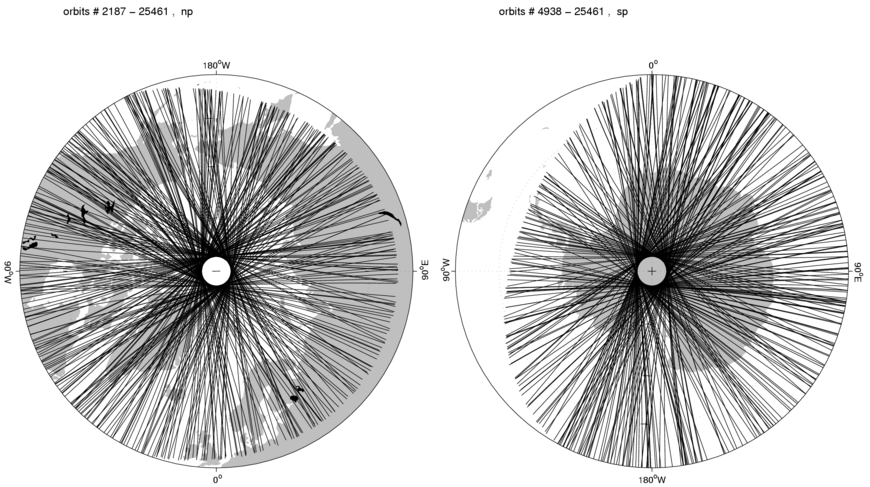It has been shown that standard magnetic activity indices like KP or DST are not very efficient for selecting periods of quiet times at auroral latitudes [Ritter et al., 2004]. Based on CHAMP data, a detailed study was conducted to develop more reliable selection criteria to identify magnetically quiet polar passes [Ritter et Lühr, 2006]. An important modulator of the auroral activity is the amount of solar illumination of the polar region. Therefore, we limited our study to 40 days centered around the hemispheric winter solstices, when the solar zenith angle in the polar region is larger than 100° at all local times. During the dark season, the ionospheric conductivity is much reduced, and generally low activity is encountered. These time intervals are of special interest for the main field modelling, because then the geomagnetic field readings, in particular the field magnitude, are only slightly affected by ionospheric currents.
At high latitudes, the ionospheric currents comprise Hall, Pedersen and field-aligned currents (FACs). All three contribute to the magnetic fields measured by satellites. As has been noted before, for main field modelling only the perturbations of the field magnitude are of concern. These deviations of the total field are produced by the toroidal current component, which is predominantly carried by Hall currents. As the activity at high latitudes is strongly controlled by the solar wind input, we also consider IMF quantities which may support very quiet conditions.
The northern dataset comprises the December solstices 2000-2004, the southern dataset comprises the June solstices 2001 - 2005, i.e. five seasons in each one. Correlations of the magnetic field scalar residuals with the merging electric field are strongest if only passes in the dayside sector are considered. The predictability improves considerably if the time sector is limited to dayside hours (08-16 MLT). Best selection results for quiet passes are obtained by combining four conditions [Ritter et Lühr, 2006]: dark season, small average merging electric field, E_m < 0.8 mV/m, absence of peak values of E_m > 1.2 mV/m during a time interval of 40 min centred at the polar crossing, and limitation to the dayside sector (08-16 MLT). The set of quiet polar passes identified by these criteria may be used beneficially in crustal field modelling of the polar regions.
| North Pole | QuietPassesNP.zip |
| South Pole | QuietPassesSP.zip |
Comment: The files contain a list of CHAMP polar passes identified as being magnetically quiet according to the selection criteria mentioned above. To account for the crossing through different MLT zones, we give the starting and end times of orbit arcs, reaching from 40° of geomagnetic latitude and up to the point closest to the geographic pole, or vice versa. In the southern hemisphere sometimes both arcs were selected due the large distance between the geomagnetic and the geographic poles. In these cases each arc is listed, both with the same orbit number.
Data Format:
| orbit No. | T1 | T2 | mlt | arc |
|---|---|---|---|---|
| 28104 | 2004.53693449 | 2004.54236273 | 8.450 | 1 |
| 28104 | 2004.54237430 | 2004.55115903 | 13.613 | 2 |
- orbit number according to the file 'orbit_No'
- T1 [MJD] start time of polar arc
- T2 [MJD] end time of polar arc
- mlt at 20° of geomagnetic co-latitude
- arc = 1 or 2: 1st or 2nd part of the polar crossing resp. flight direction of CHAMP
References
- Ritter, P., and Lühr, H., Search for magnetically quiet CHAMP polar passes and the characteristics of ionospheric currents during the dark season, Annales Geophysicae, 24, 11, 2997-3009, 2006.
- Ritter, P., Lühr, H., Viljanen, A., and Maus, S., High-latitude ionospheric currents during very quiet times: their characteristics and predictability, Annales Geophysicae, Vol. 22, 2001-2014, 2004.
Acknowledgement
We are obliged to F. Christiansen of DNSC who kindly provided us with the solar wind data (ACE) propagated to the magnetopause. Furthermore, we thank the ACE MAG and SWEPAM instrument teams and the ACE Science Center for providing the ACE data. The operational support of the CHAMP mission by the German Aerospace Center (DLR) and the financial support for the data processing by the Federal Ministry of Education (BMBF), as part of the Geotechnology Programme, are gratefully acknowledged. The DFG supported PR through the Priority Programme "Geomagnetic Variations" SPP 1097.


